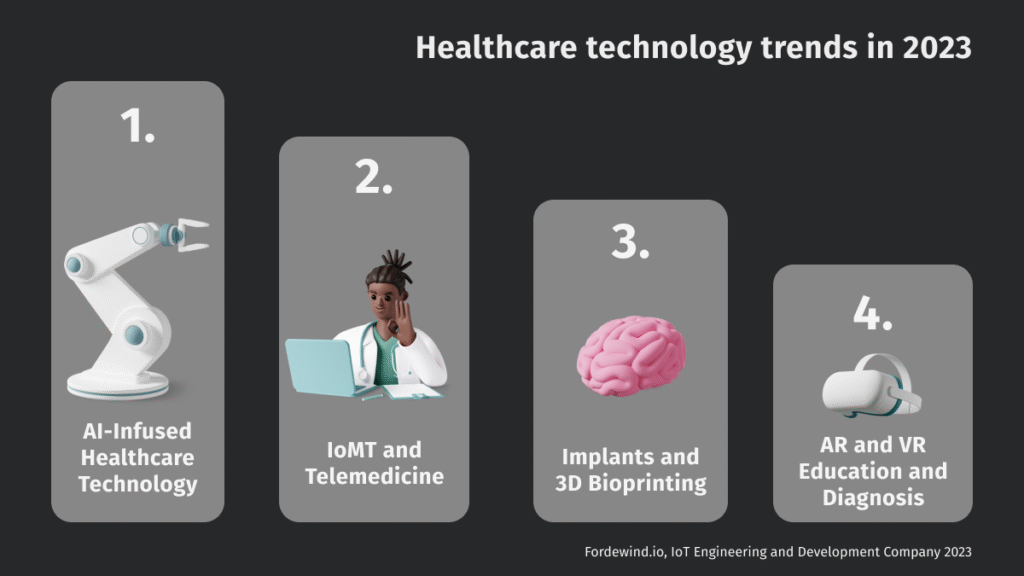✆ + 1-646-235-9076 ⏱ Mon - Fri: 24h/day
Healthcare technology trends in 2023


The healthcare industry develops with involving the latest technologies, which helps to completely change the medical approach. Healthcare technology can improve efficiency and accuracy in the diagnosis, treatment, and monitoring of patients.
The future of healthcare is definitely looking high-tech. We know that healthcare things are the IoT trends not only in 2023 but for a long time, starting from 2016.


AI-Infused Healthcare Technology
AI technology can be used to analyze large amounts of data, identify patterns, and provide insights to healthcare professionals, leading to improved patient outcomes and more personalized treatment plans. Using AI in healthcare can help medical professionals in speeding up the diagnosis process, and automate of hospital workflows through robotics, functioning chatbot symptom checkers, and good machine learning practices.
For instance, AI-infused healthcare technology includes:
-Diagnostic tools: AI can analyze medical images, such as X-rays and CT scans, to detect early signs of disease or abnormalities that human experts may miss.
-Chatbots and virtual assistants: AI-powered chatbots and virtual assistants can help patients with scheduling appointments, accessing healthcare information, and receiving advice on minor medical issues.
-Predictive analytics: AI can analyze patient data to predict health outcomes, identify patients at risk for certain conditions, and inform treatment decisions.
-Robotic surgery: AI can assist with surgical procedures, providing real-time data and enabling precision and accuracy that may be difficult to achieve with human hands alone.
Overall, AI-infused healthcare technology has the potential to revolutionize healthcare delivery and improve patient outcomes.
IoMT and Telemedicine
The Internet of Medical Things is one of the top healthcare technology trends in 2023 that everyone in the industry should be aware of as it is one of the most promising developments in digital healthcare.
IoMT refers to the network of medical devices and sensors that are connected to the internet, allowing for real-time monitoring and analysis of patient health data. Examples of IoMT devices include wearable fitness trackers, blood glucose monitors, and blood pressure monitors. The data collected from these devices can inform healthcare decisions and improve patient outcomes.
Telemedicine refers to the delivery of healthcare services using telecommunication and information technologies. This can include virtual consultations with healthcare providers, remote monitoring of patients, and the use of mobile health apps to track patient health data.
Moreover, it’s important to mention that there is a telepsychiatry for Mental Health Services.
Telepsychiatry is all about delivering mental health services through technology, such as communicating via video calls and messaging.
When IoMT and telemedicine are combined, they can enable remote patient monitoring and diagnosis, allowing healthcare providers to detect and treat health issues before they become more serious.
Implants and 3D Bioprinting
Implants refer to medical devices that are placed inside the body to replace or support damaged or diseased tissue. Examples of implants include artificial joints, dental implants, and pacemakers. Implants can be made from a variety of materials, including metals, ceramics, and polymers.
3D bioprinting involves 3D printing technology using bio-ink to create living tissue and organs. It opens up new avenues for regenerative medicine, making it possible to print new bones, cartilage, and even complete organs like hearts and livers.
AR and VR Education and Diagnosis
AR and VR can provide a more interactive and immersive experience for medical education and training, enabling medical students to see anatomy and practice procedures in a virtual environment. It will help enhance their understanding of complex medical concepts and improve their skills.
In diagnosis, AR and VR can visualize medical images, such as scans and X-rays, more interactively and intuitively, allowing medical professionals to make more informed decisions and improve patient outcomes.
AR can be used to project medical images onto a patient’s body, assisting physicians in accurately diagnosing conditions.
VR can be used to simulate complex surgical procedures, enabling doctors to practice before performing surgery on an actual patient.
Overall, healthcare technology is an important aspect of modern healthcare, helping to improve patient outcomes, reduce costs, and increase access to care.
Moreover, the healthcare industry is one of the main specializations of Fordewind.io. We develop healthcare apps, embedded systems, and all things that can help provide many medical services.
Fordewind.io is an IoT engineering and development company based in Kyiv, Ukraine. Our main areas of interest and expertise are the automotive industry and Smart Home/City projects. Contact us right now without a doubt and learn more about how we can help you build the future.